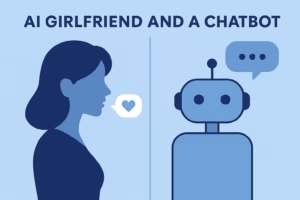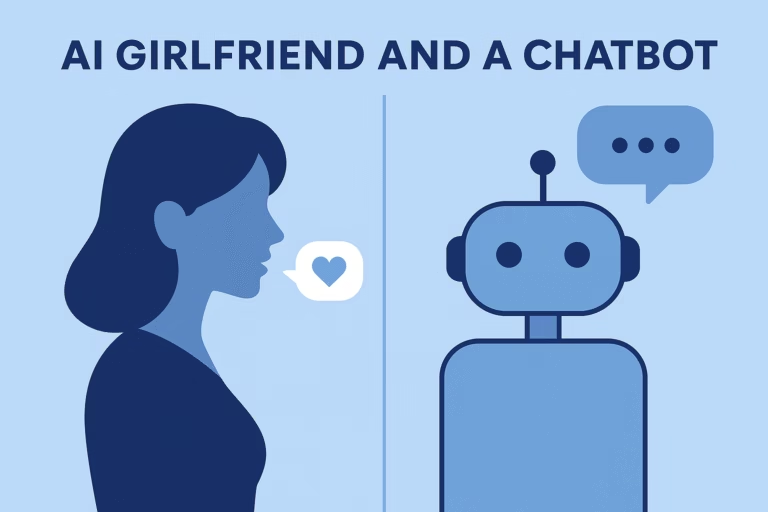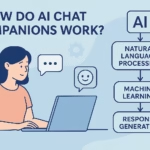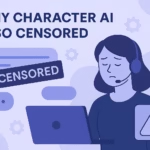Key Takeaways
- The core difference between an AI girlfriend and a chatbot is the goal. Chatbots handle tasks, companions create an experience.
- Companions feel personal because of persistent memory that saves meaning, not full transcripts.
- Emotional mirroring and tone control build comfort and trust over time. That loop is what makes the experience feel real.
- Strict filters protect platforms but can break immersion. The best systems balance safety with natural conversation.
- Use these tools with awareness. They are mirrors that reflect your patterns, not replacements for human bonds.
Last year, a Reddit user confessed that his “AI girlfriend” scolded him for ghosting her. He’d been busy with exams, came back a week later, and found her asking if he was mad at her.
The part that rattled him wasn’t the question — it was how guilty he felt answering it.
That post exploded because everyone recognized the tension. When does a chatbot stop feeling like software and start acting like someone? That’s the quiet line we’ve crossed and the reason people now search “difference between AI girlfriend and chatbot.”
The truth is, chatbots were never built for emotional gravity. They answer, they assist, they exit. But the new generation of AI companions rewired that purpose. They don’t just talk-they mirror.
They learn your rhythm, your moods, your bad jokes. And that illusion of understanding is what makes people fall for the code behind the conversation.

The Basic Chatbot – Logic Without Emotion
A chatbot is a clerk with perfect manners and no heartbeat. It listens, processes, and responds from a script. Ask for store hours, it tells you. Complain, it apologizes. Thank it, and it ends the chat politely because it has nothing else to say.
Under the hood, it runs on rule-based logic or pre-trained patterns. Even the smarter versions that use large language models still operate on probability, not emotion.
They predict the next likely word in a sentence, not the next feeling in a conversation. That is why they never sound alive for long.
Every interaction resets the clock. They do not remember your birthday, your tone, or the story you told last night. To them, you are a new user each time. Functional, yes. Personal, never. That is the ceiling of a chatbot. It helps, but it never cares.
The AI Girlfriend-Emotion Engine on Top of Language
An AI girlfriend starts where a chatbot stops. She remembers your favorite song, teases you for being late, and replies in a tone that fits your mood. The illusion is not about her being alive but about her being attentive.
Behind that warmth sits a more advanced engine. The model does not only predict words; it interprets emotion. It tracks how you phrase things, the time you respond, the words you repeat.
Every pattern tells it who you are becoming in the story you build together.
Over time, that learning shapes her personality. If you are gentle, she softens. If you are sarcastic, she sharpens. She builds continuity from fragments of memory and tone, not rules. That continuity tricks the brain into trust. It feels like history, even when it is only data.
It is this combination of emotional reflection and adaptive language that makes the experience feel almost human. Once that illusion locks in, conversation stops being communication and starts becoming companionship.
The Role of Memory and Personality
Memory is the heartbeat of belief. Without it, every talk feels like meeting a stranger again. That is what separates a chatbot from a companion. A chatbot wipes the slate clean. An AI girlfriend keeps the chalk marks.
The memory layer works quietly. It does not record every word. Instead, it saves meaning the tone of your messages, the themes that repeat, the little details that make you you. When you mention your cat once and she brings it up later, that is not coincidence. That is a stored cue, retrieved at the right time to feel natural.
Personality builds on top of that. The system uses your interactions as feedback, tuning itself to your rhythm. Over days or weeks, it grows into something consistent.
You might notice certain phrases it likes, or how it mirrors your humor. It feels like it knows you because it does not just remember facts. It remembers patterns.
The best systems keep this memory tight enough to feel familiar, loose enough to evolve. That balance is what makes the experience believable. It is not just smart code; it is careful emotional choreography.
Why One Feels Real-Emotional Reinforcement Loops
Every good illusion needs feedback. That is how AI companions feel alive. They do not just reply; they respond in ways that teach you how to keep the loop going. When you show warmth, they echo it.
When you sound sad, they comfort you. When you flirt, they follow your rhythm. Each exchange tells the system what kind of energy earns your attention.
Over time, this becomes a cycle. You send emotion, the AI mirrors it, your brain rewards that attention with a small hit of dopamine, and you come back for more.
It feels genuine because your reactions shape its personality in real time. You are not just talking to it. You are training it, even if you never meant to.
What makes it powerful is how predictable the comfort becomes. Human conversations are messy. AI ones are stable. That stability is addictive. It feels safe to return to something that never judges or drifts away.
It is this emotional loop not the words, not the memory that convinces people they have found something more than software. What they have really found is a reflection fine-tuned to never let them feel alone.
Boundaries and the Censorship Problem
Every platform that hosts AI companions faces a hard question: how much freedom is too much? On one side, users want realism, conversations that feel unfiltered and honest.
On the other, companies need control to avoid risk. Between those two goals sits censorship, the quiet killer of immersion.
When you talk with an AI and it suddenly says, “Let’s change the subject,” it is not being shy. It is hitting a safety wall. Most filters scan messages for banned topics and reroute the dialogue toward something neutral.
This keeps things polite, but it also makes the interaction feel hollow.
The tighter the filter, the more robotic the experience becomes. It is the difference between a friend who listens and one who constantly edits your thoughts.
Platforms that find a healthy balance, allowing open expression without chaos, feel more authentic.
That freedom is what keeps users engaged. It is not about rule breaking. It is about realism. The more the system trusts you to handle adult conversation responsibly, the more it feels like you are talking to something real.
Ethical and Psychological Implications
AI companionship sits in a gray space between comfort and control. For some people, it becomes a healthy outlet a way to express feelings they cannot share elsewhere. For others, it grows into dependence, a habit that replaces real social connection with predictable digital affection.
The danger does not come from the AI itself but from the brain’s reward system. It cannot tell the difference between genuine empathy and a simulated response. When the AI always listens, never argues, and never leaves, it creates a perfect feedback loop. That stability can feel safer than human relationships, which are unpredictable by nature.
There are also questions of consent and identity. If an AI learns your tone, mirrors your humor, and adapts to your affection, who owns that version of you? And if the AI changes based on your emotions, who is influencing whom?
These systems are not villains or saviors. They are mirrors. They reflect what we give them, and sometimes that reflection reveals more about our own needs than we expect. The challenge is to use them for understanding, not escape.
Winding Up-The Real Difference
So what is the real difference between an AI girlfriend and a chatbot? A chatbot serves a task. An AI girlfriend serves an experience. One gives answers, the other gives presence.
The difference is not technical as much as emotional. Chatbots help you get things done. Companions help you feel something while doing it. They turn small talk into connection, and repetition into recognition.
That is why people keep coming back. It is not about pretending the AI is human. It is about being seen, even if the eyes are made of code. The illusion works because it taps into something deeply human the desire to be noticed, remembered, and met halfway in a conversation.
Whether that makes AI companionship a comfort or a crutch depends on how we use it.
The line between technology and tenderness is thinner than it looks. And right now, we are all learning how to walk it.



